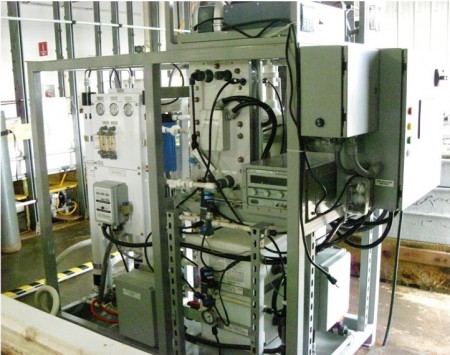Apr
9
US Navy Making Hydrocarbon Fuel From Seawater
April 9, 2014 | 9 Comments
Navy researchers at the U.S. Naval Research Laboratory (NRL), Materials Science and Technology Division have demonstrated a proof-of-concept of a novel technology developed for the recovery of carbon dioxide (CO2) and hydrogen (H2) from seawater and converting it to a liquid hydrocarbon fuel.
The Navy’s research team demonstrated sustained flight of a radio-controlled (RC) P-51 replica of the legendary Red Tail Squadron, powered by an off-the-shelf and unmodified two-stroke internal combustion engine. The replica, a high end hobbyist’s model was fueled by a liquid hydrocarbon – a component of NRL’s novel gas-to-liquid (GTL) process that uses CO2 and H2 as feedstock.
The fuel production technology uses an innovative and proprietary NRL electrolytic cation exchange module (E-CEM) of both dissolved and bound CO2 removed from seawater at 92% efficiency. The process re-equilibrates carbonate and bicarbonate to CO2 and simultaneously produces H2. The gases are then converted to liquid hydrocarbons by a metal catalyst in a reactor system.
Dr. Heather Willauer, NRL research chemist said, “In close collaboration with the Office of Naval Research P38 Naval Reserve program, NRL has developed a game changing technology for extracting, simultaneously, CO2 and H2 from seawater. This is the first time technology of this nature has been demonstrated with the potential for transition, from the laboratory, to full-scale commercial implementation.”
Here is the important data point. CO2 in the air and in seawater is an abundant carbon resource, but the concentration in the ocean (100 milligrams per liter [mg/L]) is about 140 times greater than that in air, and 1/3 the concentration of CO2 from a “stack” gas (296 mg/L). Two to three percent of the CO2 in seawater is dissolved CO2 gas in the form of carbonic acid, one percent is carbonate, and the remaining 96 to 97% is bound in bicarbonate.
The NRL effort has made significant advances in the development of a gas-to-liquids (GTL) synthesis process to convert CO2 and H2 from seawater to a fuel-like fraction of C9-C16 molecules. In the first patented step, an iron-based catalyst has been developed that can achieve CO2 conversion levels up to 60% and decrease unwanted methane production in favor of longer-chain unsaturated hydrocarbons (olefins). These value-added hydrocarbons from this process serve as building blocks for the production of industrial chemicals and designer fuels.
In the second step these olefins can be converted to compounds of a higher molecular using controlled polymerization. The resulting liquid contains hydrocarbon molecules in the carbon range, C9-C16, suitable for use a possible renewable replacement for petroleum based jet fuel.
Today’s predicted cost of jet fuel using these technologies is in the range of $3-$6 per gallon With sufficient funding and partnerships, the approach could be commercially viable within the next seven to ten years. Pursuing remote land-based options would be the first step towards a future sea-based solution.
The minimum modular carbon capture and fuel synthesis unit is envisioned to be scaled-up by the addition individual E-CEM modules and reactor tubes to meet fuel demands.
The NRL operates a lab-scale fixed-bed catalytic reactor system and the outputs of this prototype unit have confirmed the presence of the required C9-C16 molecules in the liquid. This lab-scale system is the first step towards transitioning the NRL technology into commercial modular reactor units that may be scaled-up by increasing the length and number of reactors.
The process efficiencies and the capability to simultaneously produce large quantities of H2, and process the seawater without the need for additional chemicals or pollutants, has made these technologies far superior to previously developed and tested membrane and ion exchange technologies for recovery of CO2 from seawater or air.
There are a couple very interesting things in this news. First is the natural carbon cycle process where the CO2 is already concentrated in the seawater setting up an obvious point for carbon recapture. Second, the fuels produced would be “carbon neutral” inasmuch as no new fossil fuels would be used.
What is left out so far is the capital costs per produced unit – something that industry would be far better at driving to a low cost than a military effort. Three dollar diesel isn’t so very far from today’s wholesale price.
Perhaps the best part of the news comes a nearly “free resource” as in the seawater. The energy needed to drive the process is reported to be directed at producing the hydrogen with the CO2 product nearly free. Processed together the team reports recovering CO2 and concurrently producing H2 gas eliminates the need for additional large and expensive electrolysis units.
According to the team the process efficiencies and the capability to simultaneously produce large quantities of H2, and process the seawater without the need for additional chemicals or pollutants, has made these technologies far superior to previously developed and tested membrane and ion exchange technologies for recovery of CO2 from seawater or the atmosphere.
Next up is a military scale up. Its also time for some private industry interest to take hold.
Comments
9 Comments so far




This could free the navy from having to transport jet fuels to remote bases and ships at sea. Huge potential for savings and fleet flexibility.
Note that there is no reason liquid thorium reactors could not be making automobile fuels in port cities. All it requires is a cheap safe nuclear power plant.
This lab-scale system is the first step towards transitioning the NRL technology into commercial modular reactor units that may be scaled-up by increasing the length and number of reactors. – See more at: https://newenergyandfuel.com/http:/newenergyandfuel/com/2014/04/09/us-navy-making-hydrocarbon-fuel-from-seawater/#comments
So can ocean-going vessels self fuel en route?
Carbon dioxide and bicarbonates are carbon at the lowest energy level. The sea also includes plankton which is biomass developing naturally with the help of sunlight.
The plankton can be collected by filtration of sea water and converted to syngas like any biomass. I think that it will be energy and cost effective to use this biomass as the carbon source for synthetic fuel.
Reply to Matt Musson:
Nuclear power plants are neither cheap nor safe.
if you start pulling out low carbon molecules and CO2 out of the oceans… what will be the impact on the organisms that depend on the CO2 for survival? Seawater, although abundant, has a fragile chemistry.
If you want to know how it will affect the oceans, here is a simple experiment… drink nothing but distilled water and breath nothing but pure oxygen for a few days… even hours… and tell me how you feel…
The CO2 levels in the ocean are increasing, leading to acidification which inteferes with the production of calcium carbonate shells by corals, oysters, mussels and other sealife. This will lead to the death of coral reefs which protect many tropical shorelines as well as being extremely biodiverse. Already, oyster farmers on the British Columbia, Canada coast are finding seriously reduced yields due to ocean acidification.
If this method could be scaled up to industrial levels, hopefully using solar, wind, or tidal power as the energy source, it could make a small contribution to reducing the damage.
Reply to Jagdish
The planktoni is the bottom of the ocean foodchain which sustains every other form of life in the ocean including fish we eat as well as marine mammals and seabirds. Our massive overfishing and pollution of the ocean is causing enough damage (many food fish species are facing “commercial extinction”) without strip mining the base of the foodchain for energy.
This is farcical to say the least.
The notion that there is a free lunch is a nonsense. Everything has a cost.
The most beneficial is to harvest Phyto-Plankton (Sea Weeds and the likes) in artificial sea-water or brackish water lagoons on land and use the biomass to make the Renewable Fuels. Yields per hectare are over 50 times the equivalent of biomass derived from growing sugar cane and it can be continuously harvested ready to make in to the fuels.
These lagoons with their innovative and cheap mechanical devices can produce the fuels in areas of deserts or cooling basins at power plants and the likes and the technology is already here working.